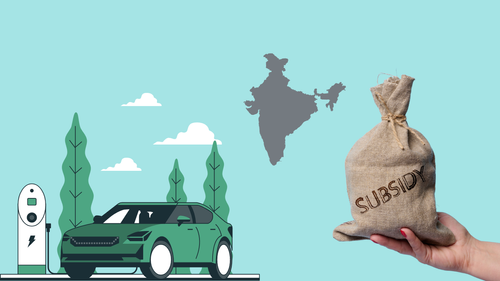EV Subsidy Guide: State-wise Benefits and Tax Discounts in India
By Mohit Kumar

44345 Views
Get insights on Electric Vehicle Subsidy in your City. Explore the subsidy per kWh and Road Tax Discount details provided on our website.

Key Highlights:
- undefined
- undefined
Electric vehicles (EVs) represent a significant step towards sustainable transportation, and India is no exception to the global shift towards electric mobility. The Indian government, at both the central and state levels, has recognized the importance of EVs in reducing carbon emissions and dependence on fossil fuels. As a result, a variety of subsidies and incentives have been introduced to accelerate the adoption of EVs across the country.
The central government's flagship initiative, the Faster Adoption and Manufacturing of (Hybrid and) Electric Vehicles (FAME) scheme, has been pivotal in this push. The FAME II scheme, which is an extension of the original FAME initiative, aims to support the electrification of public and shared transportation and to encourage the creation of EV charging infrastructure.
However, the landscape of EV subsidies is not uniform across India. Each state has the autonomy to implement its own policies and incentives, leading to a diverse array of benefits for potential EV buyers. This article provides a detailed overview of the current electric vehicle subsidies offered by various states in India, reflecting the latest updates as of 2024.
EMPS (Electric Mobility Promotional Scheme)
The Electric Mobility Promotion Scheme (EMPS) 2024 is an initiative launched by the Ministry of Heavy Industries (MHI) in India. Here are some key points about the scheme:
- The scheme was launched in March 2024 to promote electric mobility in India and boost the EV manufacturing ecosystem.
- It aims to boost the adoption of two-wheeler and three-wheeler electric vehicles for commercial purposes.
- The scheme will be implemented for four months, from 1 April 2024 to 31 July 2024.
- It has a budget of Rs. 500 crore and provides subsidies to EVs.
- Subsidies of up to Rs. 10,000 will be provided for each two-wheeler EV, up to Rs. 25,000 for each small three-wheeler EV, and up to Rs. 50,000 for each large three-wheeler EV.
- The MHI will reimburse the subsidies or demand incentives to the EV manufacturers upon the sale of a vehicle.
- The scheme targets supporting 3,72,215 EVs, specifically prioritising vehicles equipped with advanced batteries for incentives.
- Aligned with the Atma Nirbhar Bharat initiative, EMPS 2024 focuses on fostering a competitive and resilient EV manufacturing industry in India.
State Wise Subsidy for Electric Vehicle
State/Region | Subsidy per kWh | Maximum Subsidy for Four-Wheeler | Maximum Subsidy for Two-Wheelers | Road Tax Discount |
Maharashtra | ₹5,000 | ₹2,50,000 | ₹25,000 | 100% |
Gujarat | ₹10,000 | ₹1,50,000 | ₹20,000 | 50% |
Delhi | ₹5,000 | - | ₹30,000 (battery > 5 kWh) | - |
Meghalaya | ₹10,000 | ₹60,000 | ₹20,000 | 100% |
Assam | ₹10,000 | ₹1,50,000 | ₹20,000 | 100% |
Bihar | ₹10,000 | ₹1,50,000 | ₹20,000 | 100% |
West Bengal | ₹10,000 | ₹1,50,000 | ₹20,000 | 100% |
Odisha | ₹ 5,000 | ₹1,00,000 | ₹5,000 | 100% |
Rajasthan | - | - | - | - |
Kerala | - | - | - | 50% |
Karnataka | - | - | - | 100% |
Tamil Nadu | - | - | - | 100% |
Telangana | - | - | - | 100% |
Andhra Pradesh | - | - | - | 100% |
Uttar Pradesh | - | - | - | 75% |
Punjab | - | - | - | 100%
|
Maharashtra
In Maharashtra, EV buyers can avail of a subsidy of ₹5,000 per kWh of battery capacity, with a maximum subsidy cap of ₹2,50,000 for cars and ₹25,000 for two-wheelers. The state also offers a 100% discount on road tax for EVs.
Gujarat
Gujarat provides a subsidy of ₹10,000 per kWh, with a maximum subsidy of ₹1,50,000 for cars and ₹20,000 for two-wheelers. There is also a 50% discount on road tax for EVs in the state.
Delhi
Leading the way with the highest subsidy in Delhi, offering ₹5,000 per kWh, with a maximum subsidy of ₹30,000 for electric two-wheelers, provided the battery is larger than 5 kWh.
Meghalaya, Assam, Bihar, and West Bengal
These states offer a subsidy of ₹10,000 per kWh, with a maximum subsidy of ₹60,000 for cars and ₹20,000 for two-wheelers in Meghalaya, and ₹1,50,000 for cars and ₹20,000 for two-wheelers in Assam, Bihar, and West Bengal. They also provide a 100% discount on road tax.
Odisha and Rajasthan
Odisha offers a subsidy up to ₹1,00,000 for cars and ₹5,000 for two-wheelers, with a 100% discount on road tax. Rajasthan does not offer a direct subsidy but provides other incentives.
Southern States
Kerala, Karnataka, Tamil Nadu, Telangana, and Andhra Pradesh currently do not offer direct subsidies but provide a 100% road tax exemption, except for Kerala, which offers a 50% exemption.
Northern States
Uttar Pradesh and Punjab do not offer direct subsidies. Uttar Pradesh provides a 75% discount on road tax, while Punjab offers a 100% exemption.
Important Note
It is important to note that these subsidies are subject to change and may vary based on the specific models and criteria set by each state. Additionally, some states have policies that are yet to be approved, and others may introduce new incentives or modify existing ones.
The state-wise EV subsidies reflect the commitment of Indian states to promote cleaner, greener, and more sustainable modes of transportation. By providing financial incentives, they aim to reduce the initial cost barrier associated with electric vehicles, making them a more attractive option for consumers.
Carbike360 Says
For potential EV buyers, it is crucial to stay informed about the latest subsidy policies in their respective states. This knowledge can significantly influence the decision-making process and contribute to a more environmentally conscious choice.
The transition to electric vehicles is a collective effort that requires the support of government policies, industry innovation, and consumer willingness. With the continued evolution of EV subsidies and incentives, India is steadily paving the way for a future dominated by electric mobility.